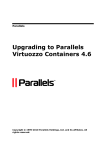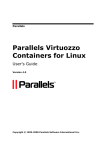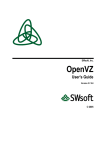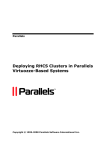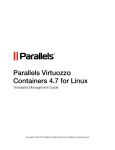Download Virtuozzo SWsoft OpenVZ User`s guide
Transcript
Parallels Virtuozzo
Containers 4.7 for Linux
Upgrade Guide
September 23, 2011
Copyright © 1999-2011 Parallels Holdings, Ltd. and its affiliates. All rights reserved.
Parallels Holdings, Ltd.
c/o Parallels International GMbH.
Parallels International GmbH
Vordergasse 49
CH8200 Schaffhausen
Switzerland
Tel: + 41 526320 411
Fax: + 41 52672 2010
www.parallels.com
Copyright © 1999-2011 Parallels Holdings, Ltd. and its affiliates. All rights reserved.
This product is protected by United States and international copyright laws. The product’s underlying technology,
patents, and trademarks are listed at http://www.parallels.com/trademarks.
Microsoft, Windows, Windows Server, Windows NT, Windows Vista, and MS-DOS are registered trademarks of Microsoft
Corporation.
Apple, Mac, the Mac logo, Mac OS, iPad, iPhone, iPod touch, FaceTime HD camera and iSight are trademarks of Apple
Inc., registered in the US and other countries.
Linux is a registered trademark of Linus Torvalds.
All other marks and names mentioned herein may be trademarks of their respective owners.
Contents
About This Document................................................................................................ 4
Upgrade Scenarios .................................................................................................... 5
Preparing for the Upgrade ........................................................................................ 7
Upgrading from Parallels Virtuozzo Containers 4.0 and 4.6 .................................... 8
Upgrading to Parallels Virtuozzo Containers 4.7 ............................................................... 9
Verifying the Upgrade .................................................................................................... 10
Upgrading Host Operating Systems with Parallels Virtuozzo Containers ............. 11
Upgrading a Host OS with Virtuozzo 3.0 ........................................................................ 12
Upgrading a Host OS with Parallels Virtuozzo Containers 4.0 or 4.6 ............................... 14
Upgrading Nodes in Clusters .................................................................................. 15
Upgrading Nodes in a Failover Cluster ........................................................................... 16
Upgrading Nodes in a Data Sharing Cluster ................................................................... 19
Upgrading from OpenVZ ......................................................................................... 22
Performing Post-Upgrade Operations ............................................................................ 24
Rolling Back to a Previous Version ......................................................................... 26
Getting Technical Support ...................................................................................... 27
CHAPTER 1
About This Document
This document familiarizes you with the way to upgrade the following products to Parallels
Virtuozzo Containers 4.7 for Linux:
•
Parallels Virtuozzo Containers 4.0 and 4.6
•
SWsoft Virtuozzo 3.0 Service Pack 1
•
OpenVZ
Note: Upgrading from the Beta version of Parallels Virtuozzo Containers 4.7 is not supported.
CHAPTER 2
Upgrade Scenarios
Before beginning the upgrade process, it is important to choose the proper upgrade scenario.
Doing so will help you avoid difficulties you may otherwise encounter and will also ensure you can
successfully solve any problems that may still occur. You can use one of the following scenarios to
upgrade your system:
First Scenario
Typically, you perform an in-place upgrade of an existing system. This upgrade scenario is
supported for servers running Parallels Virtuozzo Containers 4.0 and 4.6 and is described in
Upgrading from Parallels Virtuozzo Containers 4.0 and 4.6 (p. 8).
Second Scenario
You want to upgrade the Host operating system (Host OS) installed on your server together with
the Parallels Virtuozzo Containers software running on it. In this case, follow these steps:
1
Back up all important Virtuozzo and Container configuration files.
2
Reinstall the Host operating system on the server.
3
Install Parallels Virtuozzo Containers 4.7 on the server.
4
Restore the backed up Virtuozzo and Container configuration files.
Detailed information on this scenario is given in Upgrading Host Operating Systems with
Parallels Virtuozzo Containers (p. 11).
Third Scenario
You have a spare server to perform a new Parallels Virtuozzo Containers 4.7 installation. In this
case, follow these steps:
1
Install Parallels Virtuozzo Containers 4.7 on the spare server. If the license that you own is in the
old license format, refer to the Upgrading License Manually section below for a way to
upgrade the license to the Parallels Virtuozzo Containers 4.7 format; then use it during a fresh
installation.
2
Migrate all Containers from the Hardware Node you want to upgrade to the spare server.
3
If you store the Container (called Virtual Environment in SWsoft Virtuozzo 3.5.1 Service Pack 1)
backups on the same Hardware Node, copy the backup folder to the spare server.
4
Check that all the Containers on the spare server can be started and stopped. To do this, use
Parallels Virtual Automation, Parallels Management Console, and Parallels command-line
utilities.
Upgrade Scenarios
5
Reinstall the operating system on the Hardware Node.
6
Install Parallels Virtuozzo Containers 4.7 on the Hardware Node.
7
Migrate the Containers back from the spare server to the Hardware Node, if necessary.
Consult the Parallels Virtuozzo Containers 4.7 User's Guide and Parallels Virtuozzo Containers 4.7
Installation Guide for detailed information on how to migrate Containers between Hardware Nodes
and to perform a clean installation of Parallels Virtuozzo Containers 4.7, respectively.
Upgrade Specifics
When upgrading the Hardware Nodes included in a Virtuozzo Group (called the Virtuozzo cluster in
SWsoft Virtuozzo 3.5.1 Service Pack 1), do the following:
1
Upgrade all Slave Nodes in the Group.
2
Upgrade the Master Node.
6
CHAPTER 3
Preparing for the Upgrade
It is recommended that you do the following before starting the upgrade:
•
Install all Parallels updates available for your system.
•
Back up all Containers and virtual machines on the server.
•
Perform a full backup of the entire server using a third-party software. For example, you can
make use of the Acronis Backup & Recovery 10 Advanced Server (a free trial version is available
at http://www.acronis.com/backup-recovery/advanced-server) software allowing you to quickly
create an exact copy of your server and to easily restore the entire system if something goes
wrong during the upgrade.
CHAPTER 4
Upgrading from Parallels Virtuozzo
Containers 4.0 and 4.6
Parallels Virtuozzo Containers 4.7 officially supports an in-place upgrade on Hardware Nodes that
run Parallels Virtuozzo Containers 4.0 or 4.6 and one of the following Linux distributions (both x86
and x64 versions):
•
Red Hat Enterprise Linux 5
•
CentOS 5
It is recommended that you install the latest Parallels Virtuozzo Containers update on the Hardware
Node before starting the upgrade procedure. Use the vzup2date utility to check that you have all
of the available updates installed on the Node.
In This Chapter
Upgrading to Parallels Virtuozzo Containers 4.7 ...................................................... 9
Verifying the Upgrade ............................................................................................. 10
Upgrading from Parallels Virtuozzo Containers 4.0 and 4.6
Upgrading to Parallels Virtuozzo Containers 4.7
To upgrade your system to Parallels Virtuozzo Containers 4.7, do the following:
1
Download the vzinstall-linux-i386.bin or vzinstall-linux-x86_64.bin utility
(for the x86 or x86-64 version of Parallels Virtuozzo Containers 4.7, respectively) from the
Parallels web site.
The process of downloading and installing Parallels Virtuozzo Containers 4.7 with the
vzinstall-linux-i386.bin and vzinstall-linux-x86_64.bin utilities is the same.
Therefore, we use a generic term vzinstall-linux.bin to indicate both utilities throughout
this document.
2
Run the chmod a+x vzinstall-linux.bin command to make the vzinstalllinux.bin utility executable.
3
Execute the vzinstall-linux.bin utility. You can run vzinstall-linux.bin in one of
the following modes:
• In the 'Download and install' mode, the utility automatically starts the upgrade after it has
downloaded the Parallels Virtuozzo Containers 4.7 installation files to the server.
• In the 'Download only' mode, the utility only downloads theParallels Virtuozzo Containers
4.7 installation files but does not install them on the server. You can copy the downloaded
files to the server you plan to upgrade to Parallels Virtuozzo Containers 4.7 and execute the
following command:
# ./virtuozzo-4.7.0-<build_version>-<arch>.sfx
Detailed information on the vzinstall-linux.bin utility is provided in the Parallels
Virtuozzo Containers 4.7 Installation Guide.
During the upgrade, you will have to complete the same steps as those described in the Parallels
Virtuozzo Containers 4.7 Installation Guide for installing Parallels Virtuozzo Containers 4.7 on a fresh
Linux distribution. Consult this guide if you need more information about specific steps.
9
Upgrading from Parallels Virtuozzo Containers 4.0 and 4.6
Verifying the Upgrade
Follow these steps to verify that your system has been successfully upgraded to Parallels Virtuozzo
Containers 4.7:
•
Check that you can log in to the Hardware Node using Parallels tools: Parallels Virtual
Automation (former Parallels Infrastructure Manager and Virtuozzo Control Center) and Parallels
Management Console (former Virtuozzo Management Console).
•
Check that all Containers (formerly Virtual Environments) on the Hardware Node can be started
and stopped (using Parallels Virtual Automation, Parallels Management Console, and
command-line utilities).
•
Check that you can log in to Containers using Parallels Power Panel (former Virtuozzo Power
Panels).
10
CHAPTER 5
Upgrading Host Operating Systems with
Parallels Virtuozzo Containers
Along with upgrading the Parallels Virtuozzo Containers software, you may also wish to upgrade
the Host operating system (Host OS) installed on your server. The following table lists the types of
Host OS+Parallels Virtuozzo Containers (both Virtuozzo 3.0 Service Pack 1 and Parallels Virtuozzo
Containers 4.0 or 4.6) upgrades officially supported in Parallels Virtuozzo Containers 4.7:
Host OS before upgrade
Host OS after upgrade
CentOS 4
CentOS 6 (recommended)
CentOS 5
Red Hat Enterprise Server 4
Red Hat Enterprise Server 6 (recommended)
Red Hat Enterprise Linux 5
The procedure of upgrading Host OSs slightly differs depending on the Virtuozzo version installed
on the server and is described below.
In This Chapter
Upgrading a Host OS with Virtuozzo 3.0 ................................................................. 12
Upgrading a Host OS with Parallels Virtuozzo Containers 4.0 or 4.6 ........................ 14
Upgrading Host Operating Systems with Parallels Virtuozzo Containers
Upgrading a Host OS with Virtuozzo 3.0
To upgrade a server that runs one of the supported Host OSs and Virtuozzo 3.0 Service Pack 1, do
the following:
1
Back up all Virtuozzo and Container configuration files. These are the following files:
• /etc/sysconfig/vz-scripts/*.conf
• /etc/sysconfig/vz-scripts/*.mount
• /etc/sysconfig/vz-scripts/*.umount
• /etc/vz/*
• /etc/sysconfig/vz
• /etc/cron.d/venetclean
• /etc/cron.d/vereboot
You can back up these files to any location. For example, you can just copy them to the
/vz/conf partition that is left intact during the upgrade.
2
As with any major changes to the hard disk, it is highly recommended that you do the following
before starting the upgrade:
a
Back up all Containers (former Virtual Environments) on the Hardware Node.
b
Perform a full backup of the entire Virtuozzo server using a third-party software. For
example, you can make use of the Acronis Backup & Recovery 10 Advanced Server (a free
trial version is available at http://www.acronis.com/backup-recovery/advanced-server)
software allowing you to quickly create an exact copy of your server and to easily restore the
entire system if something goes wrong during the upgrade.
3
Reinstall the Host operating system on the server. When reinstalling the system, make sure that
the /vz partition is left intact. Once the installation is complete, restart the server.
4
Install Parallels Virtuozzo Containers 4.7. For detailed information on installing Parallels
Virtuozzo Containers 4.7, see the Parallels Virtuozzo Containers 4.7 Installation Guide. Once the
installation is complete, restart the server.
5
Restore the Virtuozzo and Container configuration files you backed up in Step 1:
• Restore the vz Virtuozzo global configuration file to the /etc/sysconfig directory.
• Restore the files /etc/sysconfig/vz-scripts/*.conf, /etc/sysconfig/vzscripts/*.mount, and /etc/sysconfig/vz-scripts/*.umount to the
/etc/sysconfig/vz-scripts directory.
• Restore the contents of the /etc/vz/* directory to the /etc/vz directory.
• Restore the files /etc/cron.d/venetclean and /etc/cron.d/vereboot to the
/etc/cron.d directory.
6
12
Drop the quota currently set for Containers, and recalculate it:
Upgrading Host Operating Systems with Parallels Virtuozzo Containers
# for i in $(ls /vz/root) ; do vzquota drop “${i}” ; done
# service vz restart
13
Upgrading Host Operating Systems with Parallels Virtuozzo Containers
Upgrading a Host OS with Parallels Virtuozzo
Containers 4.0 or 4.6
To upgrade a server that runs one of the supported Host OSs and Parallels Virtuozzo Containers
4.0 or 4.6, do the following:
1
Back up all Virtuozzo and Container configuration files. These are the following files:
• /etc/sysconfig/vz-scripts/*.conf
• /etc/sysconfig/vz
• /etc/vz/*
• /etc/cron.d/venetclean
• /etc/cron.d/vereboot
You can back up these files to any location. For example, you can just copy them to the
/vz/conf partition that is left intact during the upgrade.
2
As with any major changes to the hard disk, it is recommended that you do the following before
starting the upgrade:
a
Back up all Containers (former Virtual Environments) on the Hardware Node.
b
Perform a full backup of the entire Virtuozzo server using a third-party software. For
example, you can make use of the Acronis Backup & Recovery 10 Advanced Server (a free
trial version is available at http://www.acronis.com/backup-recovery/advanced-server)
software allowing you to quickly create an exact copy of your server and to easily restore the
entire system if something goes wrong during the upgrade.
3
Reinstall the Host operating system on the server. When reinstalling the system, make sure that
the /vz partition is left intact. Once the installation is complete, restart the server.
4
Install Parallels Virtuozzo Containers 4.7. For detailed information on installing Parallels
Virtuozzo Containers 4.7, see the Parallels Virtuozzo Containers 4.7 Installation Guide. Once the
installation is complete, restart the server.
5
Restore the Virtuozzo and Container configuration files you backed up in Step 1:
• Restore the vz Virtuozzo global configuration file to the /etc/sysconfig directory.
• Restore the /etc/sysconfig/vz-scripts/*.conf file to the
/etc/sysconfig/vz-scripts directory.
• Restore the contents of the /etc/vz/* directory to the /etc/vz directory.
• Restore the files /etc/cron.d/venetclean and /etc/cron.d/vereboot to the
/etc/cron.d directory.
6
Restart the Virtuozzo service:
# service vz restart
14
CHAPTER 6
Upgrading Nodes in Clusters
This chapter describes how to upgrade nodes running Parallels Virtuozzo Containers 4.0, Parallels
Virtuozzo Containers 4.6, or SWsoft Virtuozzo 3.0 with Service Pack 1 and participating in two
types of clusters:
•
failover clusters
•
data sharing clusters
Note: Due to discontinued support in Red Hat Enterprise Linux 6, Parallels Virtuozzo Containers 4.7 no
longer supports keeping /vz partitions on GFS1 volumes.
In This Chapter
Upgrading Nodes in a Failover Cluster ..................................................................... 16
Upgrading Nodes in a Data Sharing Cluster ............................................................. 19
Upgrading Nodes in Clusters
Upgrading Nodes in a Failover Cluster
The process of upgrading nodes in a failover cluster includes the following steps:
1
Upgrading active nodes in the cluster.
2
Upgrading passive nodes in the cluster.
Important! Upgrade one cluster node at a time. Upgrading more than one node simultaneously is
not supported and may damage your systems.
Checking Clustered Services
Each active node must be upgraded together with the clustered service running on it. So before
starting the upgrade procedure, make sure that you know which clustered service is running on
which node. To see the list of clustered services and the nodes where they are running, run this
command on any of your cluster nodes:
# clustat
Service Name
------- ---service:vz-0
service:vz-1
Owner (Last)
----- -----server1.com
server2.com
State
----started
started
Once you upgrade all active nodes in the cluster, no clustered services must be left un-upgraded.
Upgrading Active Nodes in the Cluster
First, you need to upgrade all active nodes in the failover cluster. To upgrade an active node, do the
following:
1
Freeze the clustered service running on the active node:
# clusvcadm -Z clustered_service_name
(where clustered_service_name is the name of the clustered service)
If your version of clusvcadm does not support the -Z option, use the -l option instead. This
option prevents the specified clustered service from running on a local node (that is, on the
node where you run the command). If you use the -l option, execute the command on all
cluster nodes (both active and passive), except for the node you are upgrading.
2
Open the /etc/fstab file on the node for editing, and add the /vz entry to it. Make sure you
add the right /vz entry to the file:
a
Run the clustat utility to find out the name of the clustered service running on the active
node.
b
Search the cluster configuration file (/etc/cluster/cluster.conf) for the UUID of the
device associated with the clustered service, for example:
# cat /etc/cluster/cluster.conf
...
16
Upgrading Nodes in Clusters
<service autostart="1" exclusive="1" name="vz-1" recovery="relocate">
<fs device="UUID=39028daf-0337-4403-9567-84507ac7cb50" force_fsck="0"
force_unmount="0" fstype="ext3" mountpoint="/vz" name="fs-vz-1" options=""
self_fence="0">
...
In this example, the vz-1 clustered service is associated with the device UUID
UUID=39028daf-0337-4403-9567-84507ac7cb50.
c
Add the /vz entry to /etc/fstab. For the example above, this string will look like the
following:
UUID="39028daf-0337-4403-9567-84507ac7cb50" /vz ext3 _netdev,defaults,noatime 0 0
Be sure to add the _netdev and noatime options to the entry.
3
Disable the startup of the rgmanager and cman clustering services, and enable the startup of
the vz service:
# chkconfig rgmanager off
# chkconfig cman off
# chkconfig vz on
4
Install Parallels Virtuozzo Containers 4.7 on the node. For detailed information on installing
Parallels Virtuozzo Containers 4.7, see the Parallels Virtuozzo Containers 4.7 Installation Guide;
for upgrade details, see the Upgrading from SWsoft Virtuozzo 3.0 Service Pack 1 and
Upgrading from Parallels Virtuozzo Containers 4.0 and 4.6 (p. 8) chapters.
5
Once the installation is complete, restart the node, and wait for the Parallels Virtual Automation
application to get upgraded.
6
Enable the startup of the cman and rgmanager services, and disable the startup of the vz,
pvapp, and pvaagentd services:
#
#
#
#
#
7
chkconfig
chkconfig
chkconfig
chkconfig
chkconfig
cman on
rgmanager on
vz off
pvapp off
pvaagentd off
Open the /etc/fstab file for editing, and remove the /vz entry from it.
Upgrading Passive Nodes in the Cluster
Now that you have upgraded all active nodes in the cluster, you can proceed with upgrading
passive nodes. To upgrade a passive node, do the following:
1
Make sure that the node does not have a /vz partition mounted.
2
Install Parallels Virtuozzo Containers 4.7 on the node (see instructions below). When installing
Parallels Virtuozzo Containers 4.7 on a passive node, pay attention to the following:
a
Use the --clustermode option when installing Parallels Virtuozzo Containers on passive
nodes:
• If you use the vzinstall-linux.bin utility, run this command:
# ./vzinstall-linux-x86_64.bin install --vzinstall-opts "--clustermode"
• If you use the install utility, run this command:
# ./install --clustermode
17
Upgrading Nodes in Clusters
a
If you used the Parallels Infrastructure Manager application for administering your cluster
nodes, you also need to upgrade this application. First of all, update Parallels Infrastructure
Manager to its latest version. When installing Parallels Virtuozzo Containers 4.7, specify the
--pva-agent option, for example:
# ./vzinstall-linux-x86_64.bin install --vzinstall-opts "--clustermode --pva-agent"
or
# ./install --clustermode --pva-agent
3
Disable the startup of the pvapp and pvaagentd services:
# chkconfig pvapp off
# chkconfig pvaagentd off
For detailed information on installing Parallels Virtuozzo Containers 4.7, see the Parallels Virtuozzo
Containers 4.7 Installation Guide. For upgrade details, see the Upgrading from SWsoft Virtuozzo
3.0 Service Pack 1 and Upgrading from Parallels Virtuozzo Containers 4.0 and 4.6 (p. 8)
chapters.
Finishing the Upgrade
Once you upgrade all active and passive nodes, configure the cluster configuration file
(/etc/cluster/cluster.conf) as follows:
1
Add to the <resources> section these lines:
<script file="/etc/init.d/pvaagentd" name="pvascr"/>
<script file="/etc/init.d/pvapp" name="ppscr"/>
2
Add to the <service> section of each clustered service these lines:
<script ref="pvascr"/>
<script ref="ppscr"/>
3
Increase the value of the config_version parameter by 1.
4
Save the file, and run the ccs_tool utility to update the cluster configuration.
5
Restart all cluster nodes one by one.
Finally, you need to unfreeze the clustered services on all active nodes:
# clusvcadm -U clustered_service_name
If you used the -l option to lock the clustered service, specify the -u option after clusvcadm to
unlock the service. Unlock all services on all nodes where you locked them.
18
Upgrading Nodes in Clusters
Upgrading Nodes in a Data Sharing Cluster
Like it is the case with a failover cluster, the process of upgrading nodes in a data sharing cluster
also includes two steps:
1
Upgrading active nodes in the cluster.
2
Upgrading passive nodes in the cluster.
However, each of these steps contains additional operations that you need to perform to upgrade
cluster nodes.
Important!
1. Upgrade one cluster node at a time. Upgrading more than one node simultaneously is not
supported and may damage your system.
2. Due to discontinued support in Red Hat Enterprise Linux 6, Parallels Virtuozzo Containers 4.7 no
longer supports keeping /vz partitions on GFS1 volumes.
Checking Clustered Services
Each active node must be upgraded together with the clustered service running on it. So before
starting the upgrade procedure, make sure that you know which clustered service is running on
which node. To see the list of clustered services and the nodes where they are running, run this
command on any cluster node:
# clustat
Service Name
------- ---service:vz-0
service:vz-1
Owner (Last)
----- -----server1.com
server2.com
State
----started
started
Once you upgrade all active nodes in the cluster, no clustered services must be left un-upgraded.
Upgrading Active Nodes in the Cluster
First, you need to upgrade all active nodes in the data sharing cluster. To upgrade an active node:
1
Freeze the clustered service running on all active nodes in the cluster. To do this, run the
following command on each active node:
# clusvcadm -Z clustered_service_name
(where clustered_service_name is the name of the clustered service)
If your version of clusvcadm does not support the -Z option, use the -l option instead. This
option prevents the specified clustered service from running on a local node (that is, on the
node where you run the command). If you use the -l option, execute the command on all
cluster nodes (both active and passive), except for the node you are upgrading.
19
Upgrading Nodes in Clusters
2
Disable the startup of the rgmanager clustering service, and enable the startup of the vz
service:
# chkconfig rgmanager off
# chkconfig vz on
If you are upgrading a node running SUSE Linux Enterprise Server, you need to additionally
disable the openais service:
# chkconfig openais off
3
Install Parallels Virtuozzo Containers 4.7 on the node. For detailed information on installing
Parallels Virtuozzo Containers 4.7, see the Parallels Virtuozzo Containers 4.7 Installation Guide;
for upgrade details, see the Upgrading from SWsoft Virtuozzo 3.0 Service Pack 1 and
Upgrading from Parallels Virtuozzo Containers 4.0 and 4.6 (p. 8) chapters.
4
Once the installation is complete, restart the node, and wait for the Parallels Virtual Automation
application to get upgraded. To make sure that the Parallels Virtual Automation upgrade is
complete, check that the pva-setup process is absent from the list of processes running on
the node.
5
Enable the startup of the rgmanager service, and disable the startup of the vz, pvapp, and
pvaagentd services:
#
#
#
#
chkconfig
chkconfig
chkconfig
chkconfig
rgmanager on
vz off
pvapp off
pvaagentd off
Upgrading Passive Nodes in the Cluster
Now that you have upgraded all active nodes in the cluster, you can proceed with upgrading
passive nodes. To upgrade a passive node, do the following:
1
Make sure that the node does not have a /vz partition mounted. If it does, unmount the
partition.
2
Comment the /vz entry in the /etc/fstab file.
3
Disable the startup of the cman and rgmanager services, and enable the startup of the vz
service:
4
Make sure that all NFS-related services are enabled on the node:
# chkconfig rgmanager off
# chkconfig cman off
# chkconfig vz on
5
Install Parallels Virtuozzo Containers 4.7 on the node:
a
Use the --clustermode option when installing Parallels Virtuozzo Containers 4.7 on
passive nodes:
• If you use the vzautoinstall utility, run this command:
# ./vzinstall-linux-x86_64.bin install --vzinstall-opts "--clustermode"
• If you use the install utility, run this command:
# ./install --clustermode
20
Upgrading Nodes in Clusters
a
If you used the Parallels Infrastructure Manager application (renamed to Parallels Virtual
Automation in Parallels Virtuozzo Containers 4.7) for administering your cluster nodes, you
also need to upgrade this application. First of all, update Parallels Infrastructure Manager to
its latest version. When installing Parallels Virtuozzo Containers 4.7, specify the --pvaagent option, for example:
# ./vzinstall-linux-x86_64.bin install --vzinstall-opts "--clustermode --pva-agent"
or
# ./install --clustermode --pva-agent
6
Once the installation is complete, restart the node. If you chose to upgrade Parallels Virtual
Automation, wait for it to get upgraded.
7
Make sure that the /vz directory does not contain any files or folders.
8
Uncomment the /vz entry to the /etc/fstab file.
9
Enable the startup of the cman and rgmanager services, and disable the startup of the vz,
pvapp, and pvaagentd services:
#
#
#
#
#
chkconfig
chkconfig
chkconfig
chkconfig
chkconfig
cman on
rgmanager on
vz off
pvapp off
pvaagentd off
For detailed information on installing Parallels Virtuozzo Containers 4.7, see the Parallels Virtuozzo
Containers 4.7 Installation Guide. For upgrade details, see Upgrading from SWsoft Virtuozzo 3.0
Service Pack 1 and Upgrading from Parallels Virtuozzo Containers 4.0 and 4.6 (p. 8).
Finishing the Upgrade
Once you upgrade all active and passive nodes, configure the cluster configuration file
(/etc/cluster/cluster.conf) as follows:
1
Add to the <resources> section these lines:
<script file="/etc/init.d/pvaagentd" name="pvascr"/>
<script file="/etc/init.d/pvapp" name="ppscr"/>
2
Add to the <service> section of each clustered service these lines:
<script ref="pvascr"/>
<script ref="ppscr"/>
3
Increase the value of the config_version parameter by 1.
4
Save the file, and run the ccs_tool utility to update the cluster configuration.
5
Restart all cluster nodes one by one.
Finally, you need to unfreeze the clustered services on all active nodes:
# clusvcadm -U clustered_service_name
If you used the -l option to lock the clustered service, specify the -u option after clusvcadm to
unlock the service. Unlock all services on all nodes where you locked them.
21
CHAPTER 7
Upgrading from OpenVZ
Parallels Virtuozzo Containers 4.7 allows you to upgrade servers running OpenVZ
(www.openvz.org) to Parallels Virtuozzo Containers 4.7. To do this:
1
Update OpenVZ to its latest version. You can download the latest versions of OpenVZ
packages from http://download.openvz.org.
2
Back up all OpenVZ and Container configuration files. These are the following files:
• /etc/sysconfig/vz-scripts/*.conf
• /etc/sysconfig/vz-scripts/*.mount
• /etc/sysconfig/vz-scripts/*.umount
• /etc/vz/*
• /etc/sysconfig/vz
• /etc/cron.d/venetclean
• /etc/cron.d/vereboot
You can back up these files to any location. For example, you can just copy them to the
/vz/conf partition that is left intact during the upgrade.
3
As with any major changes to the hard disk, it is highly recommended that you do the following
before starting the upgrade:
a
Back up all Containers (former Virtual Environments) on the Hardware Node.
b
Perform a full backup of the entire Virtuozzo server using a third-party software. For
example, you can make use of the Acronis Backup & Recovery 10 Advanced Server (a free
trial version is available at http://www.acronis.com/backup-recovery/advanced-server)
software allowing you to quickly create an exact copy of your server and to easily restore the
entire system if something goes wrong during the upgrade.
4
Reinstall the Host operating system on the server. When reinstalling the system, make sure that
the /vz partition is left intact. Once the installation is complete, restart the server. Install one of
the following operating systems: Red Hat Enterprise Linux 6 (recommended), CentOS 6
(recommended), Red Hat Enterprise 5, or CentOS 5.
5
Install Parallels Virtuozzo Containers 4.7. For detailed information on installing Parallels
Virtuozzo Containers 4.7, see the Parallels Virtuozzo Containers 4.7 Installation Guide. Once the
installation is complete, restart the server.
6
Restore the OpenVZ and Container configuration files you backed up in Step 1:
• Restore the vz Virtuozzo global configuration file to the /etc/sysconfig directory.
Upgrading from OpenVZ
• Restore the files /etc/sysconfig/vz-scripts/*.conf, /etc/sysconfig/vzscripts/*.mount, and /etc/sysconfig/vz-scripts/*.umount to the
/etc/sysconfig/vz-scripts directory.
• Restore the contents of the /etc/vz/* directory to the /etc/vz directory.
• Restore the files /etc/cron.d/venetclean and /etc/cron.d/vereboot to the
/etc/cron.d directory.
7
Drop the quota currently set for Containers, and recalculate it:
# for i in $(ls /vz/root) ; do vzquota drop “${i}” ; done
# service vz restart
In This Chapter
Performing Post-Upgrade Operations ..................................................................... 24
23
Upgrading from OpenVZ
Performing Post-Upgrade Operations
Use the guidelines below to configure your system once the upgrade is complete.
Installing Templates
During the upgrade, the SimFS filesystem used by OpenVZ Containers is converted to VZFS used
by Containers in Parallels Virtuozzo Containers 4.7. As a result, you cannot use old OS templates
on upgraded Nodes to create new Containers. To be able to create new Containers, you need first
to install OS templates used in Parallels Virtuozzo Containers 4.7 and called EZ templates. To install
an OS EZ template, execute the vzup2date -z command on the server, and follow the onscreen instructions. For detailed information on the vzup2date utility, see the Downloading and
Installing EZ Templates with vzup2date section in the Parallels Virtuozzo Containers 4.7
Templates Management Guide.
Once you install an OS EZ template, you can create a new Container on its basis using the -ostemplate option of the vzctl create command. For detailed information on creating
Containers, see the Parallels Virtuozzo Containers 4.7 User's Guide.
Upgrading Existing Containers
Upgraded Containers continue using old OS templates after the upgrade. To make existing
Containers fully compatible with Parallels Virtuozzo Containers 4.7, you need to install the new EZ
OS templates that correspond to the OS templates used by OpenVZ Containers. For example, if a
Container was based on the CentOS 4 OpenVZ template, install the CentOS 4 EZ OS template on
the server. Once you install an OS EZ template used by a Container, the Container automatically
starts using this template instead of the old one.
To download and install OS EZ templates, execute the vzup2date -z command on the server,
and follow the on-screen instructions. For detailed information on the vzup2date utility, see the
Downloading and Installing EZ Templates with vzup2date section in the Parallels Virtuozzo
Containers 4.7 Templates Management Guide.
Once you install an OS EZ template, you are recommended to run the vzpkg link CT_ID.
command. When executed, this command replaces real files in the Container private area with
symlinks to these very files on the server. This can free megabytes of disk space on the server. For
more information on using the vzpkg link command, see the Cleaning Up Containers section
in the Parallels Virtuozzo Containers 4.7 User's Guide.
Configuring Virtual Ethernet Network Adapters
If any of your Containers were operating in the bridged mode (that is, had one or more virtual
Ethernet adapters configured) before the upgrade, you need to re-configure these Containers once
the upgrade is complete. To do this:
24
Upgrading from OpenVZ
1
Roll back all changes you made when configuring bridge interfaces and virtual Ethernet
adapters on the server with OpenVZ. If you do not remember exactly what settings you
changed, consult the manual at http://wiki.openvz.org/VEs_and_HNs_in_same_subnets.
2
Configure the networking on the upgraded server. This includes the following steps:
a
Creating one or more Virtual Networks on the server (a counterpart of bridge interfaces in
OpenVZ).
b
Making virtual network adapters for Containers.
c
Adding Containers to the created Virtual Networks.
For detailed information on each of these steps, see the Managing Parallels Virtuozzo
Containers Network chapter in the Parallels Virtuozzo Containers 4.7 User's Guide.
25
CHAPTER 8
Rolling Back to a Previous Version
This section describes how to roll back an unsuccessful upgrade from Parallels Virtuozzo
Containers 4.7 to Parallels Virtuozzo Containers 4.6, Parallels Virtuozzo Containers 4.0, or Virtuozzo
3.0 Service Pack 1.
If the upgrade was unsuccessful, use one of the following ways to return the system to its original
state:
•
If you created a backup of the entire Hardware Node (for example, using the Acronis® True
Image Echo™ Enterprise Server software) before the upgrade, perform a full system restore by
following the instructions given in the corresponding product documentation.
•
If you backed up all Containers (former Virtual Environments) that existed on the Hardware
Node before the upgrade, but did not create a full backup of the Hardware Node, do the
following:
a
Reinstall the Linux distribution on the Node.
b
Install the original version of the product on the Node (Virtuozzo 3.0 Service Pack 1,
Parallels Virtuozzo Containers 4.0, or Parallels Virtuozzo Containers 4.6).
c
Restore the Containers from their backups.
Before starting the rollback operation, run the vzreport utility to contact the Parallels support
team and inform it of the problem you have encountered. This utility automatically collects the
necessary logs, network, system, and troubleshooting information into a single file and downloads
it to the Parallels technical support server. vzreport does not send your private information to
Parallels.
If it is impossible to make use of the vzreport utility, please back up the log files generated during
the upgrade procedure and send them to the Parallels support team. Please provide the support
team with the following log files:
•
/var/log/vzsveupgrade.log
•
/root/vzinstall.log (if you performed the upgrade using the install utility)
•
/root/virtuozzo/vzautoinstall.log (if you performed the upgrade using the
vzinstall-linux.bin utility)
CHAPTER 9
Getting Technical Support
If you experience any problems related to upgrading your software to Parallels Virtuozzo Containers
4.7, do the following:
•
If you have a Customer Relationship manager or a dedicated support engineer assigned to your
company, please feel free to contact them for any questions related to the Parallels Virtuozzo
Containers 4.7 upgrade.
•
In all other cases, use one of the following ways to get technical support from Parallels
(available 24/7 via email and phone):
• Open a support ticket by filling in a special support form at
https://www.parallels.com/en/support/virtuozzo/request/ or submitting a support request
using the vzreport utility. You can then use the Parallels Support RT self-service interface
available at https://support.parallels.com to open and track your ticket.
• If your support plan includes phone assistance, call 866.248.8906 (toll-free for US and
Canada customers) or +1.703.286.2196 (internationally).
Problem Escalation
We make every effort to ensure that your problems are processed quickly and effectively. If,
however, there are delays in processing your ticket past the time period that is stated in your
support contract, you may escalate the problem by writing a letter to
[email protected]. This email address is checked by the support leaders on a 24x7
basis. Please send the ticket ID in your email for us to be able to review the status of your ticket
and adjust the priority, if necessary. Please note that the escalation channel is not meant to provide
the support service. After you send an escalation request, the Parallels support team will either
send you a response in the corresponding ticket by email or call you.



























